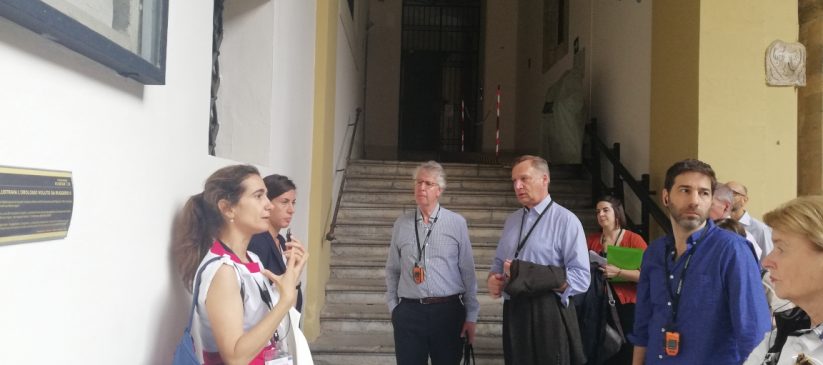
The museum staff is in Palermo for the inauguration of Manifesta 12; an excellent opportunity to visit one of the most beautiful churches in the world.
Palermo, June 14th , 2018. This morning the director of the Philadelphia Museum of Art, Timothy Rub; the director of the Collections and Exhibitions area, Alice Beamesderfer; the curator and one of the leading experts in contemporary art, Carlos Basualdo, accompanied by the rest of the museum staff, visited the Palatine Chapel of the Royal Palace and the exhibition, in Duke of Montalto Halls, “Sicilië, Pittura Fiamminga” (“Sicilië, Flemish painting”). To welcome them the coordinator of Additional Services of the Federico II Foundation, Giovanni Scaduto assisted by Valentina Bruschi, art historian, journalist and exhibition curator.
The Philadelphia Museum of Art boasts, every year, a flow of visitors of about 800 thousand people and includes, among the most influential exhibitions set up, the one dedicated to Paul Cezanne and another to Salvador Dali. Their presence in the city is linked to the inauguration tomorrow of the twelfth edition of the Manifesta biennial of contemporary art. It is natural to take this opportunity to visit the Royal Palace and one of the most beautiful churches in the world, as Guy de Maupassant called it. The visit included not only the Palatine Chapel but also the foundations of the Royal Palace and the exhibition on Flemish painting present in Sicily, recently extended until the 31st of July. Amazement and wonder were the most recurring sentiments expressed by the guests. The visitors had two exceptional guides: the art historian Valentina Bruschi and the coordinator of the Additional Services of the Federico II Foundation, Giovanni Scaduto. A careful, punctual and meticulous description that impressed, in an exceptional way, the staff of the Philadelphia museum. First of all, Timothy Rub, director of the museum. “What we found most interesting and fascinating in our visit was the stratigraphy, the levels of the history of the building, from the bottom to the top, evidence of two millennia of its past. But also the combination and mixture of cultures that is appreciated in the Palatine Chapel, the Byzantine, the Arab and the Christian, which come together in an extremely interesting way. It is my first visit to Palermo and Sicily, something I had always wanted to do, and I hope to come back because I’m only here for a few days and I would like to see other areas of Sicily “. And there was no lack of appreciation also on the exhibition “Sicilië, Pittura Fiamminga” (“Sicilië, Flemish painting”).
“This exhibition represents – said Carlos Basualdo, curator of exhibitions for the museum – a truly extraordinary collection of examples of Flemish painting. The careful and acute work aimed at collecting every single piece of art clearly aims to draw an exhaustive synthesis on the Flemish artistic moment in Sicily. It is an extraordinary painting style; in the technique and in the choice of the represented subjects”
courtesy translation Elettra La Duca